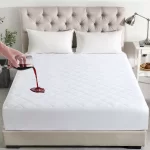A Guide to Buying the Perfect Mattress: Your Path to Restful Nights
We spend roughly a third of our lives in bed, making the choice of a mattress a decision of considerable significance. The right mattress can promote better sleep, alleviate discomfort, and improve overall health and well-being. However, with the myriad of options available in the market, finding the perfect mattress can be overwhelming. In this blog, we will walk you through the essential factors to consider when buying a mattress, ensuring that your investment leads to many nights of restful slumber.
- Understand Your Sleeping Preferences
Before embarking on your mattress-buying journey, take some time to understand your sleeping preferences. Are you a side, back, or stomach sleeper? Do you prefer a firm or plush mattress? Knowing these preferences will help you narrow down your options and choose a mattress that suits your needs.
- Determine Your Budget
Mattresses come in a wide price range, from budget-friendly options to high-end luxury models. It’s essential to establish a budget beforehand, as this will help you avoid overspending and focus on options within your price range. Keep in mind that a good mattress is an investment in your health and well-being, so be prepared to allocate a reasonable budget.
- Research Different Types of Mattresses
There are several types of mattresses available, each with its unique features and benefits. Here are some common types:
a. Innerspring Mattresses: These mattresses use a system of steel coils for support. They tend to be more affordable but may not provide as much support and longevity as other types.
b. Memory Foam Mattresses: Memory foam contours to your body’s shape, providing excellent support and pressure relief. They are a popular choice for those with back pain or joint issues.
c. Latex Mattresses: Latex mattresses are known for their durability and natural materials. They offer a balance of support and comfort.
d. Hybrid Mattresses: These mattresses combine innerspring coils with memory foam or latex layers, offering the benefits of both technologies.
e. Adjustable Air Mattresses: These mattresses allow you to adjust the firmness by inflating or deflating air chambers. They’re ideal for couples with different firmness preferences.
- Test Before You Buy
Never buy a mattress without testing it first. Visit mattress stores and spend some time lying down on different models. Pay attention to how it feels and whether it supports your body well. While you won’t truly know if a mattress is right for you until you sleep on it for a few nights, testing it in-store can help you narrow down your choices.
- Consider Your Sleeping Partner
If you share your bed with a partner, it’s crucial to choose a mattress that accommodates both of your preferences. A mattress with motion isolation can prevent disturbances when one person moves, and adjustable air mattresses often have dual controls for firmness.
- Check Warranty and Return Policies
Before making a purchase, carefully review the warranty and return policies of the mattress. A good mattress should come with a substantial warranty, typically ranging from 10 to 20 years. Additionally, understand the return policy in case you aren’t satisfied with your purchase.
- Read Reviews and Seek Recommendations
Don’t solely rely on in-store experiences. Read online reviews and seek recommendations from friends and family who have purchased mattresses recently. These insights can provide valuable information about long-term comfort and durability.
- Look for Certifications
If you’re concerned about the materials used in your mattress, look for certifications, like OEKO-TEX Standard 100 for textiles ensure that the materials used meet certain safety and environmental standards.
Conclusion
Choosing the right mattress is a decision that can significantly impact your sleep quality and overall well-being. Take your time, do your research, and consider your unique preferences and needs when making this important purchase. By following the tips outlined in this guide, you’ll be well on your way to finding the perfect mattress that will provide you with countless nights of restful sleep. Sweet dreams!
NOTE: Once you purchase a mattress protect it with a quality mattress protector from Cover and Protect Bedding Protection Specialists.




